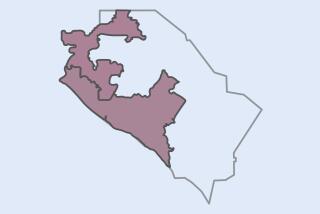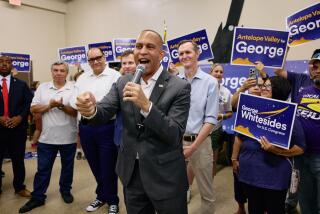Women, Minorities Contest New Terrain in House Races
WASHINGTON — As fresh faces in two unexpectedly competitive House races, Joan B. Johnson of New York and Regina Montoya Coggins of Texas have raised hopes of scoring dual gains for diversity in a Congress still ruled mostly by white men.
Johnson would be the first black Republican woman elected to Congress. Montoya Coggins, a Democrat, would be the first Latina sent to Congress from Texas.
Those would be notable achievements in a year when women and minorities are expected to make, at best, modest gains in their congressional numbers. But what makes the candidacies of these two women even more intriguing is the political terrain they are contesting: Both are running in urban-suburban “swing” districts where racial and ethnic minorities make up nowhere near a majority of the voters or the population.
There are now 62 members of Congress of minority background, most of them African American or Latino, among the 435 representatives and 100 senators. If minorities are to hold any hope of expanding their presence in Congress, they must in years to come make far more strides in regions outside the core urban districts--many with impoverished barrios and ghettos--where blacks and Latinos rose to power in the 1960s and ‘70s.
“We’re close to the limit in terms of black and Hispanic members being elected” in those districts, said David A. Bositis, senior political analyst at the Joint Center for Political and Economic Studies, a Washington think tank.
He added: “If there’s going to be any increase, it has to be in the [non-Latino] white districts.”
House Control Hinges on a Few Dozen Races
As for the congressional gender gap--just 56 House members and nine senators are women--experts agree this November’s election will be nothing like the post-Anita Faye Hill tide eight years ago that swept record numbers of women into office. Republicans hope at best to add about three or four women to their ranks, Democrats perhaps twice that number.
With control of the House hinging on a few dozen races, this year’s lineup of women and minority candidates could play a crucial role in which party claims power. California offers a striking example.
Just 10 of the state’s 52 House races are considered even remotely competitive. But of those, only the marquee race of Rep. James E. Rogan (R-Glendale) against state Sen. Adam Schiff (D-Burbank) in the 27th Congressional District features a matchup that has been the historic norm nationwide: two white men. Women and minorities are players in each of the other nine.
Among that group, Republicans are hoping that Rich Rodriguez, a Latino, can knock off Rep. Calvin M. Dooley (D-Visalia). Democrats are counting on Democratic challengers Jane Harman, running in the South Bay, and Susan A. Davis, seeking a seat in San Diego, to defeat Republican incumbents. And Hilda Solis, a Latina, is virtually assured of election in a San Gabriel Valley district after defeating Rep. Matthew Martinez in the Democratic primary (Martinez has since switched parties and is finishing his term as a Republican).
The stakes are high and the playing field is small--a swing of as few as seven House seats nationwide could topple the GOP majority. Ellen Malcolm, president of EMILY’s List, a group that promotes Democratic female candidates who favor abortion rights, argues that female candidates alone could make the difference. “I think we could take back enough House seats with our women candidates to take back control of the House,” Malcolm said.
That’s a large leap. It assumes that several contenders, such as Montoya Coggins, can make inroads in Republican territory.
Running in the 5th Congressional District of Texas, which includes a patch of Dallas and several counties to the southeast, Montoya Coggins, a 46-year-old attorney, faces two-term Republican Rep. Pete Sessions. He is favored to win but is by no means a shoo-in. In the early ‘90s, the seat was in Democratic hands. Montoya Coggins surprised independent analysts by raising more than $1.1 million for her campaign by the end of June--a total all the more notable considering that she has never held elective office.
Montoya Coggins is waging a standard Democratic campaign on issues such as education and expanding government health insurance with prescription drug coverage. With only one-third of the district’s population of minority descent, she acknowledges that her Mexican American background can take her only so far.
“I hope that when people vote for me and look to me, they take me as a whole person,” Montoya Coggins said. But she knows she is exploring a new political frontier, adding, “You’re going to be seeing more and more people who are minorities running in districts that were not designed to elect minorities.”
Numbers Lopsided on Capitol Hill
Across the country, Democrats historically have built an edge over Republicans in the number of minority lawmakers, often by consolidating power in districts with substantial blocs of minority voters.
The numbers on Capitol Hill are lopsided. Black Democratic representatives outnumber Republicans 36 to 1. Among Latinos, the breakdown is 15 to 4. Among Asian/Pacific Islander Americans in Congress, there are five Democrats and no Republicans.
This year, the only Asian American with a strong chance to gain a congressional seat is Mike Honda, a Japanese American running in California’s 15th District. That seat, in the Silicon Valley suburbs, is being vacated by Rep. Tom Campbell of San Jose, the state’s Republican Senate nominee. Honda is in a tight race with Republican Jim Cunneen.
Honda, addressing the Democratic convention last month in Los Angeles, mocked Republicans’ attempts to court minority voters at their convention in Philadelphia. “Republicans staged diversity,” Honda said. “Democrats are diversity.”
Republicans vigorously dispute attacks on the sincerity of their efforts. They acknowledge the immensity of the task confronting them in a state like California--where non-Latino whites are no longer a majority--and elsewhere in the country where minorities increasingly are moving into the suburbs. But with Texas Gov. George W. Bush running as their presidential nominee with a slogan of “compassionate conservatism,” Republicans see reason to hope they can make gains in this and subsequent elections if he is elected.
Another major challenge for the GOP is to bolster its roster of female candidates. Party leaders are hard-pressed to explain why there are more than twice as many Democratic women in Congress--45--as Republican--20.
Democrats claim that they more easily attract female candidates because of their party’s position on gun control, education and abortion rights. Republicans scoff at this notion but agree that they need more women running on the party’s policies.
“We’ve got a great message,” said Rep. Thomas M. Davis of Virginia, chairman of the National Republican Congressional Committee. “We just can’t have all middle-aged white men delivering the message.” Enter Joan B. Johnson.
Johnson, 66, town clerk of Islip on Long Island, emerged as the GOP candidate for New York’s 2nd Congressional District after Rep. Rick Lazio became the party’s choice to run for Senate. Johnson’s race, against a Democratic opponent to be chosen in a primary next Tuesday, is rated a tossup.
Johnson has attracted nationwide notice as the only African American woman in her party with a shot at Congress. The sudden celebrity, Johnson said, “has been incredible.”
Though she deviates from the Republican line on a few social issues--she favors abortion rights, for instance--Johnson counts herself a solid partisan. While she notes four of five people in her district are non-Latino whites, Johnson said she is happy to answer questions about her racial background to help raise awareness “that there is an opportunity for blacks in the Republican Party.”
Much Demographic Change Unlikely
Experts say the timing of this year’s election limits the advances of female and minority candidates. Typically, the best opportunities for newcomers come in the first election after political boundaries are redrawn to account for population shifts found in a national census. That would point to a shake-up in the House in 2002.
But even in the Senate, which is not affected by the census, this year seems unlikely to bring much demographic change. No blacks, Latinos or Asian Americans are given a credible shot at ousting an incumbent or winning an open seat. Among female candidates, the best hopes are Democrats: First Lady Hillary Rodham Clinton in New York and Rep. Debbie Stabenow in Michigan.
Female senators share a bipartisan yen for more peers. This summer, the six Democratic and three Republican women who serve in the Senate released a book titled “Nine and Counting.”
(BEGIN TEXT OF INFOBOX / INFOGRAPHIC)
Women and Minorities in Congress
The number of women, blacks and Latinos in Congress has risen steadily over the past 30 years, in part a result of the civil rights and women’s rights movements. The number of Asian/Pacific Islander Americans, however, has remained stagnant.
*
NOTE: There is one American Indian in Congress, Sen. Ben Nighthorse Campbell (R-Colo.). House totals count only the 435 voting representatives, excluding nonvoting delegates.
*
Sources: Congressional Quarterlys Guide to Congress, Congressional Black, Asian Pacific American and Hispanic Caucuses, Center for American Women and Politics, Congressional Research Service.
Compiled by SUNNY KAPLAN / Los Angeles Times
More to Read
Get the L.A. Times Politics newsletter
Deeply reported insights into legislation, politics and policy from Sacramento, Washington and beyond. In your inbox three times per week.
You may occasionally receive promotional content from the Los Angeles Times.










